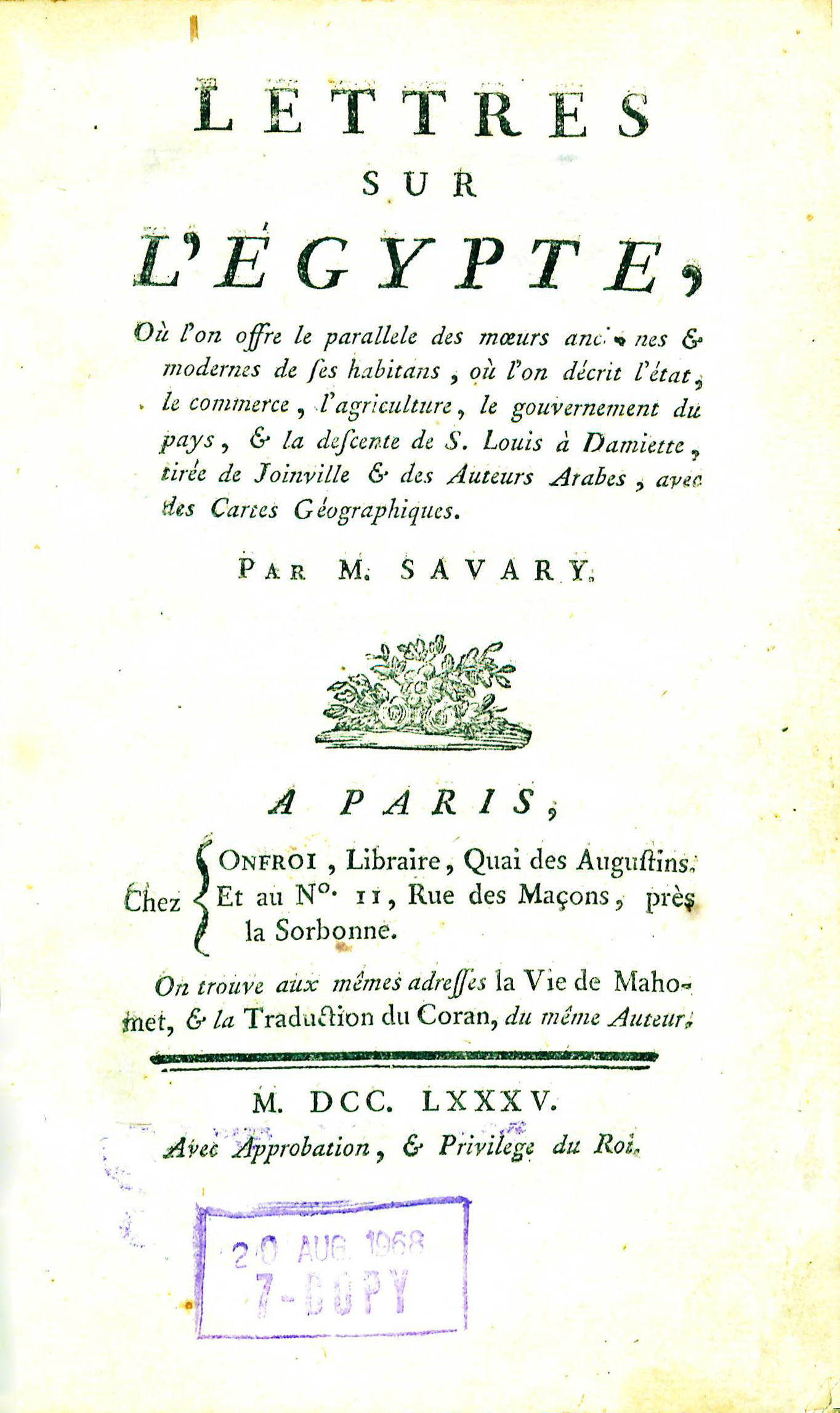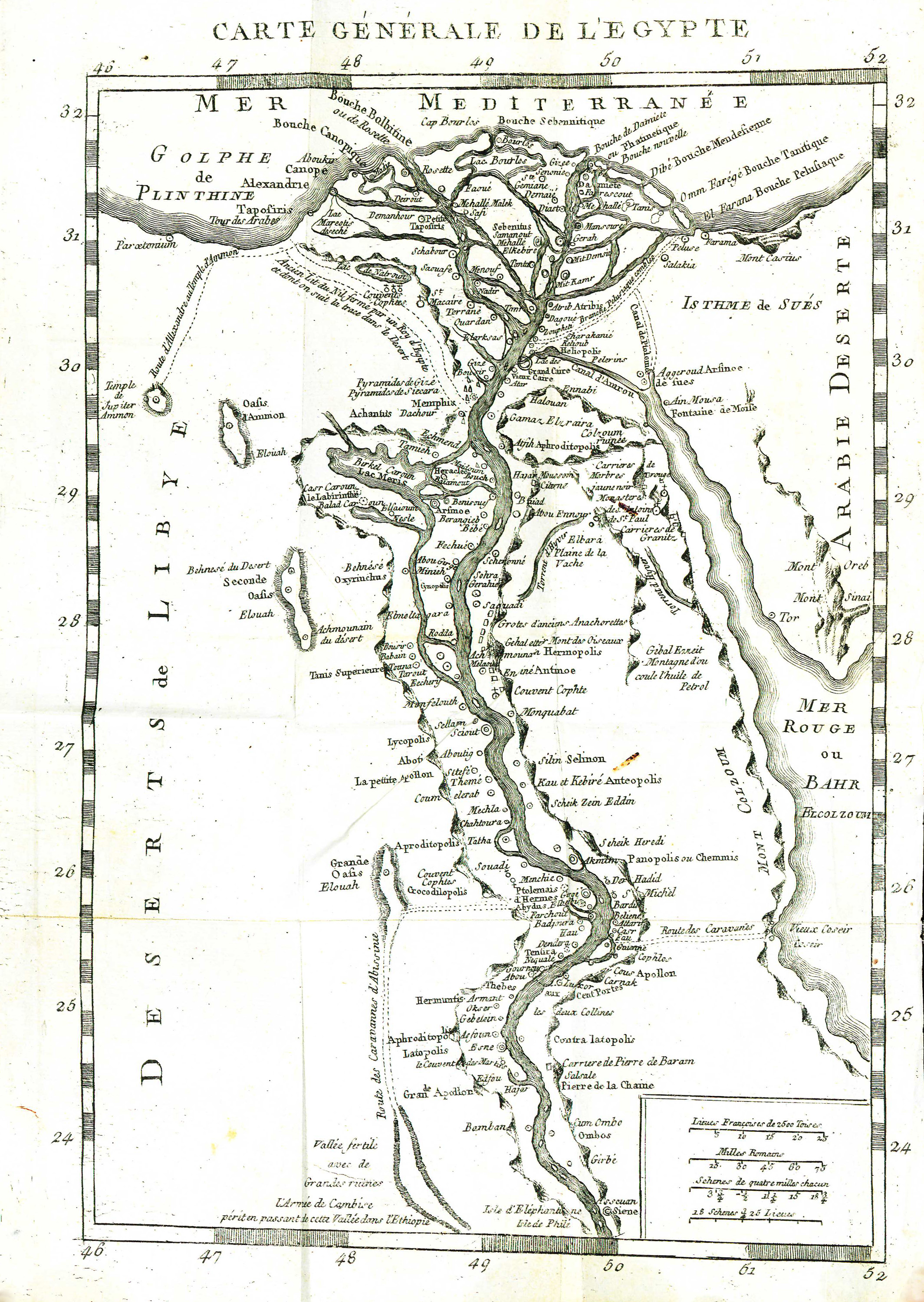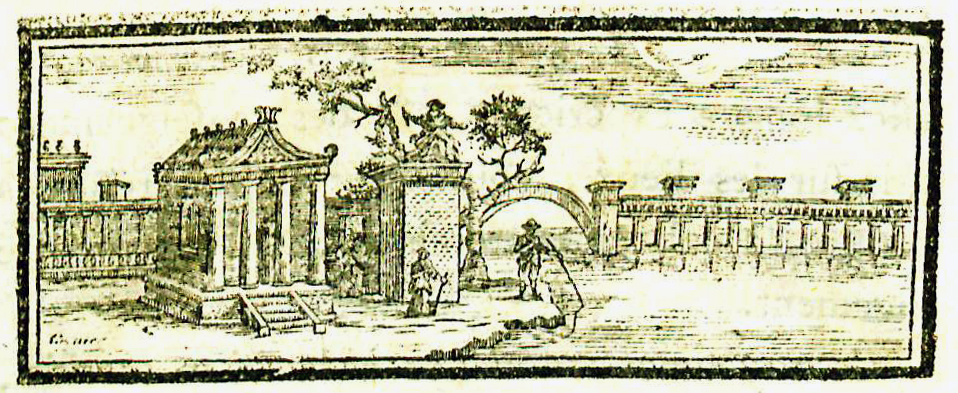Difference between revisions of "Lettres sur l'Égypte"
Mvanwicklin (talk | contribs) m |
m |
||
| (4 intermediate revisions by the same user not shown) | |||
| Line 4: | Line 4: | ||
{{BookPageInfoBox | {{BookPageInfoBox | ||
|imagename=SavaryLettresSurL'Egypte1785.jpg | |imagename=SavaryLettresSurL'Egypte1785.jpg | ||
| − | |link= | + | |link=https://wm.primo.exlibrisgroup.com/permalink/01COWM_INST/g9pr7p/alma991017618289703196 |
|shorttitle=Lettres sur l'Égypte | |shorttitle=Lettres sur l'Égypte | ||
|vol=volume one | |vol=volume one | ||
| Line 14: | Line 14: | ||
|set=3 | |set=3 | ||
|desc=[[:Category:Octavos|8vo (20 cm.)]] | |desc=[[:Category:Octavos|8vo (20 cm.)]] | ||
| − | |shelf=C- | + | |shelf=C-1 |
}}[[File:SavaryLettresSurLEgypte1785v2Map.jpg |left|thumb|300px|<center>Map of Egypt, volume two.</center>]][http://en.wikipedia.org/wiki/Claude-Étienne_Savary Claude-Étienne Savary] (1750-1788) traveled to Egypt in 1776 and remained there for three years.<ref>Louis-Gabriel Michaud, ed., ''Biographie Universelle Ancienne et Moderne: Histoire par Ordre Alphabétique de la Vie Publique et Privée de Tous les Hommes qui sont Fait Remarquer par Leurs écrits, Leurs Actions, Leurs Talents, Leurs Virtues ou Leurs Crimes'' (Paris: Chez Madame C. Desplaces, 1843), 108-109.</ref> His three volume ''Lettres sur l’Egypte'' includes not only his own personal recollections, but also observations about ancient and modern Egypt that he drew in part from Arab authors little known to his European audience.<ref>Robert Kerr, ''A General History and Collection of Voyages and Travels, Arranged in Systematic Order: Forming a Complete History of the Origin and Process of Navigation, Discovery, and Commerce, by Sea and Land, from the Earliest Ages to the Present Time'' (Edinburgh: William Blackwood, 1824), 18:596.</ref> Savary’s writing was highly praised at the time of its publication for its “picturesque style” and “vivid descriptions.”<ref>Michaud, ''Biographie Universelle Ancienne et Moderne''.</ref> The ''Lettres'' were translated into English, German, Dutch, and Swedish.<ref>Kerr, ''A General History and Collection of Voyages and Travels''.</ref> However, the work did garner criticism from those who felt the book was more novel than nonfiction, that Savary’s observations were exaggerated, and that he was prone to making mistakes when calculating dates.<ref>Michaud, ''Biographie Universelle Ancienne et Moderne''.</ref> By the ninteenth century, the ''Lettres'' had lost much of their popularity, due to the aforementioned reasons and because Savary’s writing was considered overly extravagant.<ref>Kerr, ''A General History and Collection of Voyages and Travels''.</ref> | }}[[File:SavaryLettresSurLEgypte1785v2Map.jpg |left|thumb|300px|<center>Map of Egypt, volume two.</center>]][http://en.wikipedia.org/wiki/Claude-Étienne_Savary Claude-Étienne Savary] (1750-1788) traveled to Egypt in 1776 and remained there for three years.<ref>Louis-Gabriel Michaud, ed., ''Biographie Universelle Ancienne et Moderne: Histoire par Ordre Alphabétique de la Vie Publique et Privée de Tous les Hommes qui sont Fait Remarquer par Leurs écrits, Leurs Actions, Leurs Talents, Leurs Virtues ou Leurs Crimes'' (Paris: Chez Madame C. Desplaces, 1843), 108-109.</ref> His three volume ''Lettres sur l’Egypte'' includes not only his own personal recollections, but also observations about ancient and modern Egypt that he drew in part from Arab authors little known to his European audience.<ref>Robert Kerr, ''A General History and Collection of Voyages and Travels, Arranged in Systematic Order: Forming a Complete History of the Origin and Process of Navigation, Discovery, and Commerce, by Sea and Land, from the Earliest Ages to the Present Time'' (Edinburgh: William Blackwood, 1824), 18:596.</ref> Savary’s writing was highly praised at the time of its publication for its “picturesque style” and “vivid descriptions.”<ref>Michaud, ''Biographie Universelle Ancienne et Moderne''.</ref> The ''Lettres'' were translated into English, German, Dutch, and Swedish.<ref>Kerr, ''A General History and Collection of Voyages and Travels''.</ref> However, the work did garner criticism from those who felt the book was more novel than nonfiction, that Savary’s observations were exaggerated, and that he was prone to making mistakes when calculating dates.<ref>Michaud, ''Biographie Universelle Ancienne et Moderne''.</ref> By the ninteenth century, the ''Lettres'' had lost much of their popularity, due to the aforementioned reasons and because Savary’s writing was considered overly extravagant.<ref>Kerr, ''A General History and Collection of Voyages and Travels''.</ref> | ||
==Evidence for Inclusion in Wythe's Library== | ==Evidence for Inclusion in Wythe's Library== | ||
| − | Listed in the [[Jefferson Inventory]] of [[Wythe's Library]] as ''Lettres de Savary sur l’Egypte 3.v. 8vo.'' and given by [[Thomas Jefferson]] to his son-in-law, [[Thomas Mann Randolph]]. Jefferson sent the set to Wythe while | + | Listed in the [[Jefferson Inventory]] of [[Wythe's Library]] as ''Lettres de Savary sur l’Egypte 3.v. 8vo.'' and given by [[Thomas Jefferson]] to his son-in-law, [[Thomas Mann Randolph]]. Jefferson sent the set to Wythe while serving as Minister to France.<ref>See: [[Thomas Jefferson to Wythe, 16 September 1787]].</ref> A copy of the second edition, published in 1786, at the University of Virginia includes the signatures "T. M. Randolph" and "G. Randolph" but has no markings linking it to Wythe. Nevertheless, both [http://www.librarything.com/profile/GeorgeWythe George Wythe's Library]<ref>''LibraryThing'', s.v. "[http://www.librarything.com/profile/GeorgeWythe Member: George Wythe]," accessed on November 19, 2013.</ref> on LibraryThing and the [https://digitalarchive.wm.edu/handle/10288/13433 Brown Bibliography]<ref>Bennie Brown, "The Library of George Wythe of Williamsburg and Richmond," (unpublished manuscript, May, 2012) Microsoft Word file. Earlier edition available at: https://digitalarchive.wm.edu/handle/10288/13433.</ref> list the University of Virginia copy and use its edition information to identify Wythe's copy. Barbara Dean also includes this edition in her [[Dean Bibliography|bibliographic memo]].<ref>[[Dean Bibliography|Memorandum from Barbara C. Dean]], Colonial Williamsburg Found., to Mrs. Stiverson, Colonial Williamsburg Found. (June 16, 1975), 5 (on file at Wolf Law Library, College of William & Mary).</ref> The Wolf Law Library followed these sources and purchased the second edition. |
==Description of the Wolf Law Library's copy== | ==Description of the Wolf Law Library's copy== | ||
Bound in full mottled calf bindings with gilt decorated spines and head and tail pieces throughout. Volume one stamped "Library of Congress surplus duplicate" on verson of front free endpaper and "20 AUG 1968, 7-COPY" on title page. Volumes two and three stamped "20 AUG 1968, 7-COPY" on half-titles. Purchased from Eveleigh Books.<br /> | Bound in full mottled calf bindings with gilt decorated spines and head and tail pieces throughout. Volume one stamped "Library of Congress surplus duplicate" on verson of front free endpaper and "20 AUG 1968, 7-COPY" on title page. Volumes two and three stamped "20 AUG 1968, 7-COPY" on half-titles. Purchased from Eveleigh Books.<br /> | ||
<br /> | <br /> | ||
| − | Images of the library's copy of this book are [https://www.flickr.com/photos/wolflawlibrary/sets/72157637697637256 available on Flickr.] View the record for this book in [ | + | Images of the library's copy of this book are [https://www.flickr.com/photos/wolflawlibrary/sets/72157637697637256 available on Flickr.] View the record for this book in [https://wm.primo.exlibrisgroup.com/permalink/01COWM_INST/g9pr7p/alma991017618289703196 William & Mary's online catalog.] |
[[File:SavaryLettresSurLEgypte1785v3Headpiece.jpg|center|thumb|350px|<center>Headpiece, first page of text, volume three.</center>]] | [[File:SavaryLettresSurLEgypte1785v3Headpiece.jpg|center|thumb|350px|<center>Headpiece, first page of text, volume three.</center>]] | ||
Latest revision as of 09:43, 23 May 2024
by M. Claude Etienne Savary
| Lettres sur l'Égypte | |
|
Title page from Lettres sur l'Égypte, volume one, George Wythe Collection, Wolf Law Library, College of William & Mary. | |
| Author | M. Claude Étienne Savary |
| Published | Paris: Onfroi |
| Date | 1785-1786 |
| Language | French |
| Volumes | 3 volume set |
| Desc. | 8vo (20 cm.) |
| Location | Shelf C-1 |
Evidence for Inclusion in Wythe's Library
Listed in the Jefferson Inventory of Wythe's Library as Lettres de Savary sur l’Egypte 3.v. 8vo. and given by Thomas Jefferson to his son-in-law, Thomas Mann Randolph. Jefferson sent the set to Wythe while serving as Minister to France.[7] A copy of the second edition, published in 1786, at the University of Virginia includes the signatures "T. M. Randolph" and "G. Randolph" but has no markings linking it to Wythe. Nevertheless, both George Wythe's Library[8] on LibraryThing and the Brown Bibliography[9] list the University of Virginia copy and use its edition information to identify Wythe's copy. Barbara Dean also includes this edition in her bibliographic memo.[10] The Wolf Law Library followed these sources and purchased the second edition.
Description of the Wolf Law Library's copy
Bound in full mottled calf bindings with gilt decorated spines and head and tail pieces throughout. Volume one stamped "Library of Congress surplus duplicate" on verson of front free endpaper and "20 AUG 1968, 7-COPY" on title page. Volumes two and three stamped "20 AUG 1968, 7-COPY" on half-titles. Purchased from Eveleigh Books.
Images of the library's copy of this book are available on Flickr. View the record for this book in William & Mary's online catalog.
See also
References
- ↑ Louis-Gabriel Michaud, ed., Biographie Universelle Ancienne et Moderne: Histoire par Ordre Alphabétique de la Vie Publique et Privée de Tous les Hommes qui sont Fait Remarquer par Leurs écrits, Leurs Actions, Leurs Talents, Leurs Virtues ou Leurs Crimes (Paris: Chez Madame C. Desplaces, 1843), 108-109.
- ↑ Robert Kerr, A General History and Collection of Voyages and Travels, Arranged in Systematic Order: Forming a Complete History of the Origin and Process of Navigation, Discovery, and Commerce, by Sea and Land, from the Earliest Ages to the Present Time (Edinburgh: William Blackwood, 1824), 18:596.
- ↑ Michaud, Biographie Universelle Ancienne et Moderne.
- ↑ Kerr, A General History and Collection of Voyages and Travels.
- ↑ Michaud, Biographie Universelle Ancienne et Moderne.
- ↑ Kerr, A General History and Collection of Voyages and Travels.
- ↑ See: Thomas Jefferson to Wythe, 16 September 1787.
- ↑ LibraryThing, s.v. "Member: George Wythe," accessed on November 19, 2013.
- ↑ Bennie Brown, "The Library of George Wythe of Williamsburg and Richmond," (unpublished manuscript, May, 2012) Microsoft Word file. Earlier edition available at: https://digitalarchive.wm.edu/handle/10288/13433.
- ↑ Memorandum from Barbara C. Dean, Colonial Williamsburg Found., to Mrs. Stiverson, Colonial Williamsburg Found. (June 16, 1975), 5 (on file at Wolf Law Library, College of William & Mary).
External Links
Read volume two of this book in Google Books.


